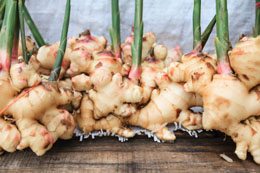Ginger plant grows well in a fertile and well-drained soil that receives filtered sunlight. Read on to know more about how to plant ginger.

Ginger refers to the fleshy tuber of ginger plant, the scientific name of which is
Zingiber officinale. It is a flavoring culinary herb used for preparing a wide variety of delicacies and also for making herbal tea. Apart from the culinary usage, it is an important medicinal herb, which is effective for therapeutic treatment of nausea, diarrhea, pain, and migraine. Due to its attractive blooms, fragrance, and several uses, ginger plant is popularly grown as a part of vegetable and/or herbal garden.
Most garden enthusiasts prefer to grow this plant for creating landscaping design, especially in the home boundaries. Since it is native to tropical and subtropical regions, the plant grows best in warm environmental conditions. In addition to this growing criteria, there are certain tips for increasing the yield of ginger root. Let us take a look at the tips on how to plant ginger.
Planting and Caring Tips
Ginger plants can be grown both in the garden or in pots and containers. The basic requirements for a good harvest are fertile soil, proper drainage, filtered sunlight, high humidity, and warm climatic conditions. A few things to avoid while planting ginger are waterlogged soil, full sunlight, very strong winds, low temperature conditions, and heavy frost.
- Selecting Growing Site:
Selecting a growing site is one of the most crucial steps for planting ginger roots. An improper site may result in poor formation of the rhizomes. Hence, while deciding the plantation site, always consider the basic requirements of ginger plants. If your garden soil and/or area is not suitable for growing ginger plants, always prefer growing them in pots of proper size so that you can provide the optimum requirements to some extent. For example, if your garden site receives direct sunlight, then you can protect the plants during peak hours by placing them indoors.
- Soil Preparation:
The best time for planting this herb is winter and early spring. For the plantation of ginger roots, prepare the soil after heavy frost is over. You can add farmyard compost with the garden soil in 1:1 proportion. If your garden soil is wet and heavy, you can create raised beds in order to minimize excessive water accumulation. Doing so ensures proper drainage and prevents water logging.
- Choosing Ginger Rhizome:
The planting material for growing ginger is rhizomes. Selecting healthy rhizomes is as important as deciding the plantation site. Always opt for fresh and plump rhizomes with healthy growth buds. You can select well-developed eyes in the tip portion of the rhizomes. Cut the rhizomes into pieces, ensuring that each bud consists of healthy eyes. For fastening shoot development, you can soak the rhizomes in water overnight.
- Planting Ginger Root:
After preparing the soil, you can place the rhizome pieces with the growth buds pointing upwards at a depth of about 6-8 cm. If you are planting in the garden soil, leave a space of about 4-5 inches in between two plantations. Accordingly, you can also plant the ginger roots in pots. Carefully cover the growth buds with soil.
- Watering Ginger Plants:
Speaking about watering of ginger plants, they require regular watering every two days. Do not over water the plants, as it will result in water logging. In order to maintain the humidity level, you can provide heavy mulching around the plants. Mulching also helps in controlling the growth of weeds.
- Caring Tips:
For ginger plant care, supplementing the soil with fertilizers after every four months is necessary. You can also spray the leaves with liquid fertilizers. For better development of the rhizomes, reduce watering the plants during dry spells. If the leaves are dried out, it is time to harvest the rhizomes. Harvesting of ginger rhizome is perfect about 8 months after plantation. In order to harvest, dig up the soil around the plant carefully. You can pull out the stem along with the rhizomes.
So, with these tips, you can plant this herb in your garden and enjoy its aromatic roots as well as the vibrantly colored flowers.






 Ginger refers to the fleshy tuber of ginger plant, the scientific name of which is Zingiber officinale. It is a flavoring culinary herb used for preparing a wide variety of delicacies and also for making herbal tea. Apart from the culinary usage, it is an important medicinal herb, which is effective for therapeutic treatment of nausea, diarrhea, pain, and migraine. Due to its attractive blooms, fragrance, and several uses, ginger plant is popularly grown as a part of vegetable and/or herbal garden.
Ginger refers to the fleshy tuber of ginger plant, the scientific name of which is Zingiber officinale. It is a flavoring culinary herb used for preparing a wide variety of delicacies and also for making herbal tea. Apart from the culinary usage, it is an important medicinal herb, which is effective for therapeutic treatment of nausea, diarrhea, pain, and migraine. Due to its attractive blooms, fragrance, and several uses, ginger plant is popularly grown as a part of vegetable and/or herbal garden.